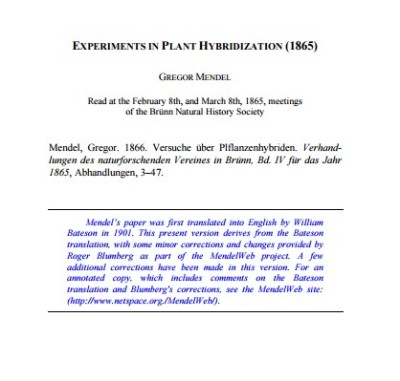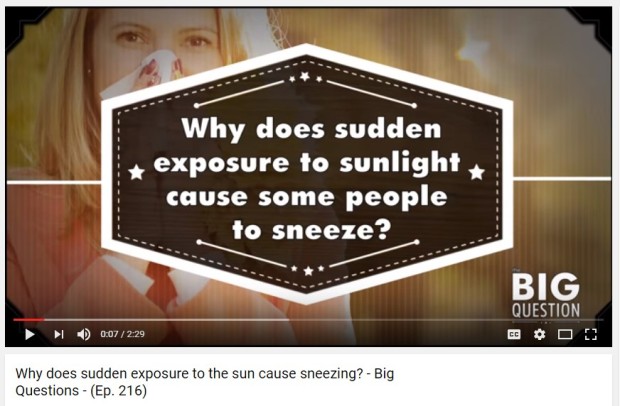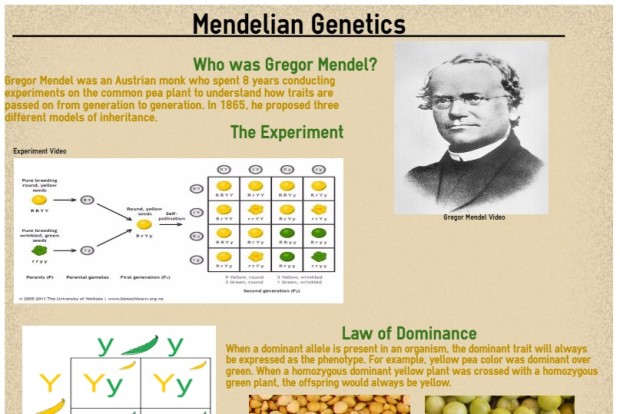Experiments in Plant Hybridization (1865)

Mendel, G. (1866). EXPERIMENTS IN PLANT HYBRIDIZATION (1865). Verhandlungen Des Naturforschenden Ver-eines in Brünn, 4, 3-47. Retrieved July 16, 2016, from http://old.esp.org/foundations/genetics/classical/gm-65-a.pdf
SUMMARY AND TEXT USE
This is the original paper Mendel wrote based off of his pea plant experiment. It summarizes his experimental set up, his results, and the conclusions he drew based off of his results. This would give the students an insight into his thought process and how he came up with his three laws. This text would serve as a close reading exercise at the end of the unit. It requires background information on Mendelian genetics and a previous understanding of his experiment. I would have the students perform a close reading on his closing remarks in the paper where he discusses his conclusions. It is important for students to read this because it gives the students a better understanding of the experiment that changed the field of genetics. While reading, I will have my students focus on answering the question, “How did Mendel use his results to come up with his three laws of inheritance?”
TEXT COMPLEXITY
According to the website storytoolz.com, the quantitative score places this text at an average grade level of 18. I agree with this score because it is a complex subject that has a great deal of vocabulary that is necessary to understand. However, I believe that high school students will be able to understand it because I will be using it as a close reading. We will only focus on the concluding remarks and we can analyze the text to ensure the students understand what Mendel wrote.
VOCABULARY
Hybrids, homozygous, heterozygous, offspring, predominance, dominant, recessive, propagation
An Illustration of Gregor Mendel’s Findings on the Genetics of Pea Plants

Kline, M. (n.d.). An Illustration of Gregor Mendel’s Findings on the Genetics of Pea Plants [Cartoon]. In Dogfoose.com. Retrieved July 26, 2016, from http://dogfoose.com/infotoons/
Did Abraham Lincoln Have a Genetic Mutation?

Horowitz, K. (2016, March 17). Did Abraham Lincoln Have a Genetic Mutation? Retrieved July 24, 2016, from http://mentalfloss.com/article/77320/did-abraham-lincoln-have-genetic-mutation
SUMMARY AND TEXT USE
This is an interesting article because it connects to a person of significance in the United States: Abraham Lincoln. It shows how people have traced Lincoln’s family for 200 years and diagnosed Lincoln with Marfan syndrome. This is a great article to be used to show how traits can be traced throughout generations due to Mendelian inheritance. I would use this article to allow students to see how Mendelian genetics is used today and how they can trace inheritance through their own families. After reading this article, I would have my students perform an activity that involves tracing a trait throughout their family tree, such as eye or hair color, widows peak, etc. This would allow them to understand how Harold Schwartz, the diagnostic physician, was able to trace his family back to Lincoln’s great-great grandfather to see the history of Marfan syndrome. This article would be used after the students learn the basics of Mendelian genetics and to get them interested in its applications to the world and their own lives.
TEXT COMPLEXITY
According to storytoolz, the quantitative text complexity is at an average grade level of 12.6. There are some more complex sentences due to word and sentence length, however,I disagree with this score because this article is not extremely dense and does not have a great amount of vocabulary or complex ideas involved. This is a fairly straightforward article that any 9th grader would be able to understand with some vocabulary clarification
VOCABULARY
Marfan Syndrome, connective tissue, melancholic, geneticist, moot, genes
Why does sudden exposure to the sun cause sneezing? – Big Questions – (Ep.216)

MentalFlossVideo. (2016). Why does sudden exposure to the sun cause sneezing? – Big Questions – (Ep. 216). Retrieved July 19, 2016, from https://www.youtube.com/watch?v=cMcAPozI0uQ
SUMMARY AND TEXT USE
This short video answers a viewer’s question on why does sudden exposure to sunlight cause some people to sneeze? This video goes in-depth on a few theories that can cause this reflex. However, scientist agree that it is genetic and if a person has this trait, they have a fifty percent chance of passing it on to their child. They have not found the gene that causes this reflex, but research is being performed because it can lead into new information regarding other problems such as migraines and epilepsy. This text would be used as a “attention getter” before introducing genetics. Students will find this interesting because in the video, it states that between 10 to 35 percent of people experience this reflex. Students will be intrigued by this because they may be affected or may know someone who is affected by this reflex. While watching this, I would have my students think about who in their families are affected by this reflex and think about why this would run in families and why it wouldn’t be a “random” phenomenon.
TEXT COMPLEXITY
Again, using storytoolz, the text was determined to have a quantitative grade level of 10.2. I agree with this score because this video contains ideas that the students will not be familiar with, especially because this will be used as an introduction to the unit. Most likely, the students will not have any background of this material, therefore, the complexity of the text would rate higher. This video is full of complex vocabulary and concepts such as the various theories that are discussed. However, if I were to show this video after the unit, I would put it at an 8th grade level because the video itself is very clear and is easily understood with the correct background knowledge.
VOCABULARY
Photic, autosomal, dominant, inherit, parasympathetic nervous system, epilepsy, reflex
Infographic on Mendelian Genetics

Mendelian Laws of Inheritance.” 2016. http://www.scienceclarified.com/Ma-Mu/Mendelian-Laws-of-Inheritance.html (July 18, 2016).
Miko, Illona. 2008. “Gregor Mendel and the Principles of Inheritance.” Nature Education 1(1): 134.
Updegaff, Emily. 2016. “Explanation of Mendel’s Three Laws Through the Discussion of Meiosis.” http://education.seattlepi.com/explanation-mendels-three-laws-through-discussion-meiosis-3838.html (July 18, 2016)
Created by Megan Looby http://easel.ly/infographic/i29os4
Overall, I would use all of these texts throughout the entire lesson on Mendelian genetics. I would use the MentalFlossVideo video as an attention grabber to capture the student’s interest in Mendelian genetics. Next, I would use the cartoon to help illustrate Mendel’s complex experiment. This would help to simplify one trait he tested so students can understand his experimental setup. After learning the basics of Mendelian genetics, the students would then read the Abraham lincoln article to see how genetic traits can be traced throughout generations and have them trace their own trait through their family. Then, the students would perform a close reading of Mendel’s concluding remarks from is 1866 paper he wrote after performing his experiment. With their knowledge of the paper and Mendel’s three laws, students will be able to see how he came up with the laws based off of his results. Finally, the inforgrapic would serve as a review tool for the assessment on Mendelian genetics. This disciplinary text set is a valuable tool that can help deepen the students understanding of a concept that is the basis of gentics.
Nice work Megan. You used a variety of texts that appeal to different types of learners, and they are all quite informative as well. I think the video about sunlight making people sneeze is an excellent attention grabber. I personally always wondered why that happened and it got me interested. I also found the Lincoln article informative and interesting, and I agree with you that it is not as complex as storytoolz.com said it was. It is a good Idea to end the unit with the mendel paper. Because this is the hardest to read, it is best to have them read it in the end, after they have learned a lot of the vocabulary and the basic concepts of Mendelian genetics. High school students may need some help, but think it is important for them to be able to read real scientific papers, and see the original source of such valuable knowledge.
LikeLike
this is Joel
LikeLike